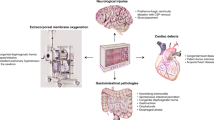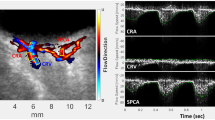Abstract
Objective
Evaluate physiologic changes during digital retinal imaging (DRI) using near infra-red spectroscopy (NIRS).
Study design
Prospective observational study of preterm infants undergoing retinopathy of prematurity screening via DRI using wide-field retinal camera. Cardiorespiratory (CR) and NIRS data were collected, trends correlated for changes and coefficient representing “slopes” of outcomes were plotted over time. The p value associated with each slope coefficient was tested to assess for slope differences from time of intervention (time = 0/or no slope).
Results
Thirty-one preterm infants were included in the study. There were no significant changes in pre- and post-slopes for cerebral or mesenteric oxygenation, or CR indices with eye drop administration compared to baseline. DRI resulted in significant increase in post exam slope in cerebral oxygenation, mesenteric oxygenation and respiratory rate.
Conclusion
ROP examination using DRI was well tolerated with slight improvements in cerebral and mesenteric perfusion without significant safety concerns.
This is a preview of subscription content, access via your institution
Access options
Subscribe to this journal
Receive 12 print issues and online access
$259.00 per year
only $21.58 per issue
Buy this article
- Purchase on Springer Link
- Instant access to full article PDF
Prices may be subject to local taxes which are calculated during checkout


Similar content being viewed by others
References
Purisch SE. Epidemiology of preterm birth. Semin Perinatol. 2017;41:387–91.
Gilbert C. Childhood blindness in the context of VISION 2020-the right to sight. Bull World Health Organ. 2003;79:227–32.
Rahi JS. Severe visual impairment and blindness in children in the UK. Lancet. 2003;362:1359–65.
Fierson WM. Screening Examination of Premature Infants for Retinopathy of Prematurity. Pediatrics. 2018;142:1–9.
Kovács G, Somogyvari Z, Maka E, Nagyjanosi L. Bedside ROP screening and telemedicine interpretation integrated to a neonatal transport system: Economic aspects and return on investment analysis. Early Hum Dev. 2017;106:1–5.
Richter GM, Williams SL, Starren J, Flynn TJ, Chiang MF. Telemedicine for retinopathy of prematurity diagnosis: evaluation and challenges. Surv Ophthalmol. 2009;54:671–85.
Ells AL, Holmes JM, Astle WF, Willians G, Leske DA, Fielden M, et al. Telemedicine approach to screening for severe retinopathy of prematurity: a pilot study. Ophthalmology. 2003;110:2113–7.
Slevin M, Murphy JF, O’Keefe M. Retinopathy of prematurity screening, stress related responses, the role of nesting. Br J Ophthalmol. 1997;81:762–4.
Fijalkowski N, Zheng LL, Henderson MT, Wang SK, Wallenstein MB, Leng T, et al. Stanford University Network for Diagnosis of Retinopathy of Prematurity (SUNDROP): five years of screening with telemedicine. Ophthalmic Surg Lasers Imaging Retin. 2014;45:106–13.
Mukherjee AN, Watts P, Al-Madfai H, Manoj B, Roberts D. Impact of retinopathy of prematurity screening examination on cardiorespiratory indices: a comparison of indirect ophthalmoscopy and retcam imaging. Ophthalmology. 2006;113:1547–52.
Vesoulis ZA, Mintzer JP, Chock VY. Neonatal NIRS monitoring: recommendations for data capture and review of analytics. J Perinatol. 2021;41:675–88.
Pavlek LR, Mueller C, Jebbia MR, Kielt MJ, Fathi O. Near-Infrared Spectroscopy in Extremely Preterm Infants. Front Pediatrics. 2021;8;973.
Bailey SM, Hendricks-Munoz KD, Mally P. Cerebral, renal, and splanchnic tissue oxygen saturation values in healthy term newborns. Am J Perinatol. 2014;31:339–44.
Vesoulis ZA, Lust CE, Liao SM, Trivedi SB, Mathur AM. Early hyperoxia burden detected by cerebral near-infrared spectroscopy is superior to pulse oximetry for prediction of severe retinopathy of prematurity. J Perinatol. 2016;36:966–71.
van der Heide M, Hulscher JBF, Bos AF, Kooi. EMW Near-infrared spectroscopy as a diagnostic tool for necrotizing enterocolitis in preterm infants. Pediatric Res. 2021;90:148–155.
Schat TE, Zoonen AGJF, van der Laan ME, Mebius MJ, Bos AF, Hulzebos CV, et al. Early cerebral and intestinal oxygenation in the risk assessment of necrotizing enterocolitis in preterm infants. Early Hum Dev. 2019;131:75–80.
Ostojic D, Jiang J, Isler H, Kleiser S, Karen T, Wolf M, et al. Impact of Skull Thickness on Cerebral NIRS Oximetry in Neonates: an in silico Study. Adv Exp Med Biol. 2020;1232:33–38.
van Bel F, Lemmers P, Naulaers G. Monitoring Neonatal Regional Cerebral Oxygen Saturation in Clinical Practice: Value and Pitfalls. Neonatology. 2008;94:237–44.
Ranger M, Albert A, MacLean K, Holsti L. Cerebral hemodynamic response to a therapeutic bed for procedural pain management in preterm infants in the NICU: a randomized controlled trial. Pain Rep. 2021;6:e890.
Alderliesten T, van Bel F, van derAa NE, Steendijk P, van Haastert IC, de Vries LS, et al. Low Cerebral Oxygenation in Preterm Infants Is Associated with Adverse Neurodevelopmental Outcome. J Pediatrics. 2019;207:109–16.
Variane GFT, Chock VY, Netto A, Pietribom RFR, Van Meurs KP. Simultaneous Near-Infrared Spectroscopy (NIRS) and Amplitude-Integrated Electroencephalography (aEEG): Dual Use of Brain Monitoring Techniques Improves Our Understanding of Physiology. Front Pediatrics. 2019;7:1–8.
Marin T, Moore J, Kosmetatos N, Roback JD, Weiss P, Higgins M, et al. Red blood cell transfusion-related necrotizing enterocolitis in very-low-birthweight infants: a near-infrared spectroscopy investigation. Transfusion. 2013;53:2650–8.
Braski K, Weaver-Lewis K, Loertscher M, Ding Q, Sheng X, Baserga M. Splanchnic-Cerebral Oxygenation Ratio Decreases during Enteral Feedings in Anemic Preterm Infants: Observations under Near-Infrared Spectroscopy. Neonatology. 2018;113:75–80.
Acknowledgements
The authors gratefully acknowledge the contributions of their subjects, their subjects’ families, and their colleagues. This work has been supported by departmental funds.
Author information
Authors and Affiliations
Contributions
Conceptualization/design/methodology: RV, EZ, TK, PV, PS, RS. Investigation/formal analysis: RV, KW, PS, PV, RS. Paper drafting: RV, EZ, TK, RS. Paper editing: All authors. All authors gave final approval of the version to be published. All authors agree to be accountable for all aspects of the work.
Corresponding author
Ethics declarations
Competing interests
The authors declare no competing interests.
Ethical approval
The study was reviewed and approved by Baystate Health Institutional Review Board and was exempt from requiring written consent.
Additional information
Publisher’s note Springer Nature remains neutral with regard to jurisdictional claims in published maps and institutional affiliations.
Rights and permissions
About this article
Cite this article
Vaidya, R., Zitnik, E., Kita, T. et al. Utilizing near infra-red spectroscopy to identify physiologic variations during digital retinal imaging in preterm infants. J Perinatol 42, 378–384 (2022). https://doi.org/10.1038/s41372-021-01294-1
Received:
Revised:
Accepted:
Published:
Issue Date:
DOI: https://doi.org/10.1038/s41372-021-01294-1



